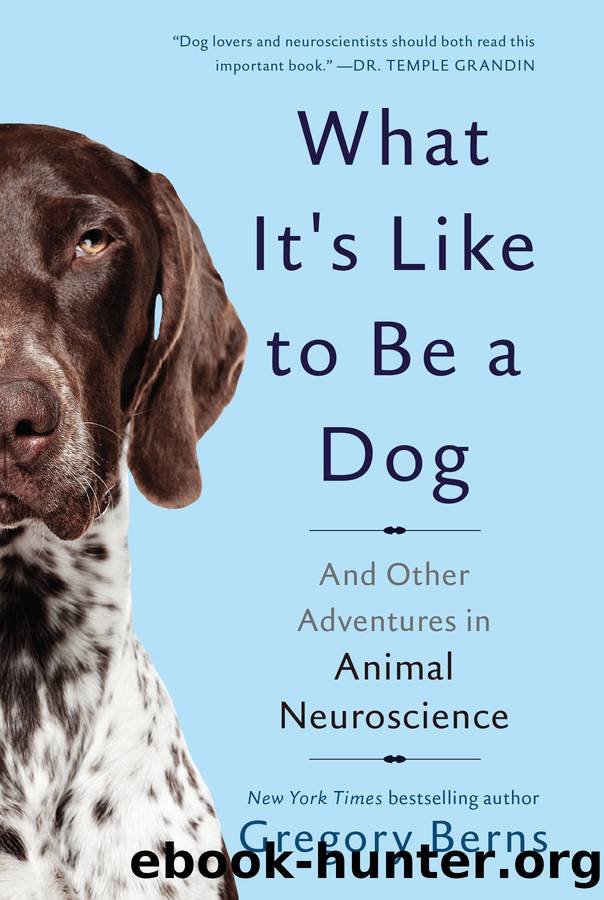What It's Like to Be a Dog by Gregory Berns

Author:Gregory Berns [BERNS, GREGORY]
Language: eng
Format: epub
Publisher: Basic Books
Published: 2017-09-05T00:00:00+00:00
Chapter 8
Talk to the Animals
âCallie!â I said, âGet hedgehog!â
She waggled her whole rear in excitement and looked at me with an expression that I took to mean: This is fun! She spun around and trotted over to the lineup of objects I had placed on the floor across the room. Callie passed by several coffee mugs and nudged the spiky stuffed animal that I had dubbed âhedgehog.â
I pushed the handheld clicker, indicating that she had picked the correct object, and Callie zoomed back to me to gobble up a piece of hot dog as a reward.
For the next trial, I wanted her to go to a rectangular piece of blue foam. I said, âCallie, get blue!â
She looked at me and then, wagging her tail, looked at the array of objects across the room.
âCallie! Go get blue.â
She trotted over to the hedgehog and nosed it a few times. Not hearing the click, she looked back at me.
I did my best to remain expressionless.
After a few seconds, Callie gave up on the hedgehog. But instead of going to the foam block, she walked over to a doorstop poking out of the baseboard.
âSorry, girl. Thatâs not it.â I motioned her to come back.
We tried it three more times. Despite having trained the word association to the foam block many times, she still wanted to go to the hedgehog. Maybe the hedgehog was just more fun to play with, but the way Callie was making errors seemed to say something important about how she processed language.
Although Callie was semiretired from the Dog Project, I still worked with her to debug new experiments. I was trying to teach her some simple word-object associations. And it wasnât going very well.
This particular experiment was inspired by the growing number of reports of dogs with large vocabularies. In 2004, a border collie named Rico was reported to have learned over two hundred words for different objects. And then, in 2011, John Pilley, a psychology professor, trained his border collie, Chaser, on more than one thousand words. Chaser created quite a buzz in the scientific community. If she could learn that many words, did that mean that all dogs had this capability? More fundamentally, did Chaser just associate arbitrary sounds with specific objects, or did she have some rudimentary knowledge that a sound like âBinkyâ could be the name for a thing?
The question was one of semantic knowledge.
Did dogs have semantic systems in their brains? It would be remarkable if Chaser understood that words had meaning, and even more so if she understood that meaning could change depending on the context. Until recently, nobody had really thought to look. Most of the efforts in animal language had focused on primatesâchimpanzees and bonobos. But apart from a few individuals, there was not much evidence that even our closest relatives had much in the way of language ability or semantic knowledge. Part of the problem was knowing what an animal knew.
I wanted to do more than just learn what Callie knew. I wanted to talk to her in a way that she could understand.
Download
This site does not store any files on its server. We only index and link to content provided by other sites. Please contact the content providers to delete copyright contents if any and email us, we'll remove relevant links or contents immediately.
Sapiens: A Brief History of Humankind by Yuval Noah Harari(13052)
The Tidewater Tales by John Barth(12030)
Do No Harm Stories of Life, Death and Brain Surgery by Henry Marsh(6336)
Mastermind: How to Think Like Sherlock Holmes by Maria Konnikova(6235)
The Thirst by Nesbo Jo(5785)
Why We Sleep: Unlocking the Power of Sleep and Dreams by Matthew Walker(5641)
Sapiens by Yuval Noah Harari(4537)
Life 3.0: Being Human in the Age of Artificial Intelligence by Tegmark Max(4507)
The Longevity Diet by Valter Longo(4445)
The Rules Do Not Apply by Ariel Levy(3905)
The Immortal Life of Henrietta Lacks by Rebecca Skloot(3826)
The Body: A Guide for Occupants by Bill Bryson(3800)
Why We Sleep by Matthew Walker(3771)
Animal Frequency by Melissa Alvarez(3755)
Yoga Anatomy by Kaminoff Leslie(3701)
Barron's AP Biology by Goldberg M.S. Deborah T(3631)
The Hacking of the American Mind by Robert H. Lustig(3580)
All Creatures Great and Small by James Herriot(3515)
Yoga Anatomy by Leslie Kaminoff & Amy Matthews(3395)
